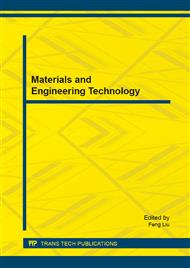[1]
Ivan Uzunov, Dobromir Gaydajiev, Ventsislav Yantchev, Improvement of the frequency response of FBAR filters by using parallel or series connected resonators instead of single resonators, Proc. IEEE International Conference on Microwaves, Communications, Antennas and Electronic Systems (COMCAS 2011), 1-9, (2011).
DOI: 10.1109/comcas.2011.6105793
Google Scholar
[2]
Mingke Qi, Daihua Zhang, Wei Pang, High performance TD-SCDMA band-pass filter based on film bulk acoustic resonator technology, Proc. 2012 Asia Pacific Microwave Conference, 547-549, (2012).
DOI: 10.1109/apmc.2012.6421659
Google Scholar
[3]
Huijin Zhang, Shurong Dong, Weiwei Chen, MIMO Multiplexer Based on Film Bulk Acoustic Resonator, IEEE Transactions on Consumer Electronics, 56(2), 805-810 (2010).
DOI: 10.1109/tce.2010.5506005
Google Scholar
[4]
Lakin. K. M, Kline. G. R, McCarron. K. T, High Q microwave acoustic resonators and filters, IEEE Transactions on Microwave Theory and Techniques, 41(12), 2139-2146, (1993).
DOI: 10.1109/22.260698
Google Scholar
[5]
Larson. J. D., Bradley. P. D., Wartenberg. S., Modified butterworth-van dyke circuit for FBAR resonators and automated measurement system, Proc. 2000 IEEE Ultrasonics Symposium, 863-868, (2000).
DOI: 10.1109/ultsym.2000.922679
Google Scholar
[6]
Southin. J. E., Whatmore. R. W., Finite Element Modelling of Nanostructured Piezoelectric Resonators (NAPIERs), IEEE Transactions on Ultrasonics, Ferroelectrics, and Frequency Control, 51(6), 654-662, (2004).
DOI: 10.1109/tuffc.2004.1304263
Google Scholar
[7]
Shijie Liu, Research of FBAR Temperature Sensor, Hangzhou: Zhejiang University, (2012).
Google Scholar
[8]
Wei Pang, Hongyu Yu, Hao Zhang, Temperature-Compensated Film Bulk Acoustic Resonator Above 2 GHz, IEEE Electron Device Letters, 26(6), 369-371, (2005).
DOI: 10.1109/led.2005.848113
Google Scholar
[9]
Farina Marco, Rozzi Tullio, Electromagnetic Modeling of Thin-Film Bulk Acoustic Resonators, IEEE Transactions on Microwave Theory and Techniques, 52(11), 2496-2502, (2004).
DOI: 10.1109/tmtt.2004.837152
Google Scholar
[10]
Dong Shu-rong, Jin Hao, Wang De-miao, Electromagnetic analysis of thin film bulk acoustic resonator, Journal o f Zhejiang University (Engineering Science), 40(9), 1477-1481, (2006).
Google Scholar
[11]
Huijin Zhang, Research on FBAR Modeling and Some Applications, Hangzhou: Zhejiang University, (2011).
Google Scholar
[12]
Su Q. -X., Kirby P., Komuro E., et al., Thin-Film Bulk Acoustic Resonators and Filters Using ZnO and Lead–Zirconium–Titanate Thin Films, IEEE Transactions on Microwave Theory and Techniques, 49(4), 769-778, (2001).
DOI: 10.1109/22.915462
Google Scholar
[13]
Reinhold Ludwig, Pavel Bretchko, RF Circuit Design: Theory and Applications, Prentice hall, New Jersey, 2000, pp.28-29.
Google Scholar


